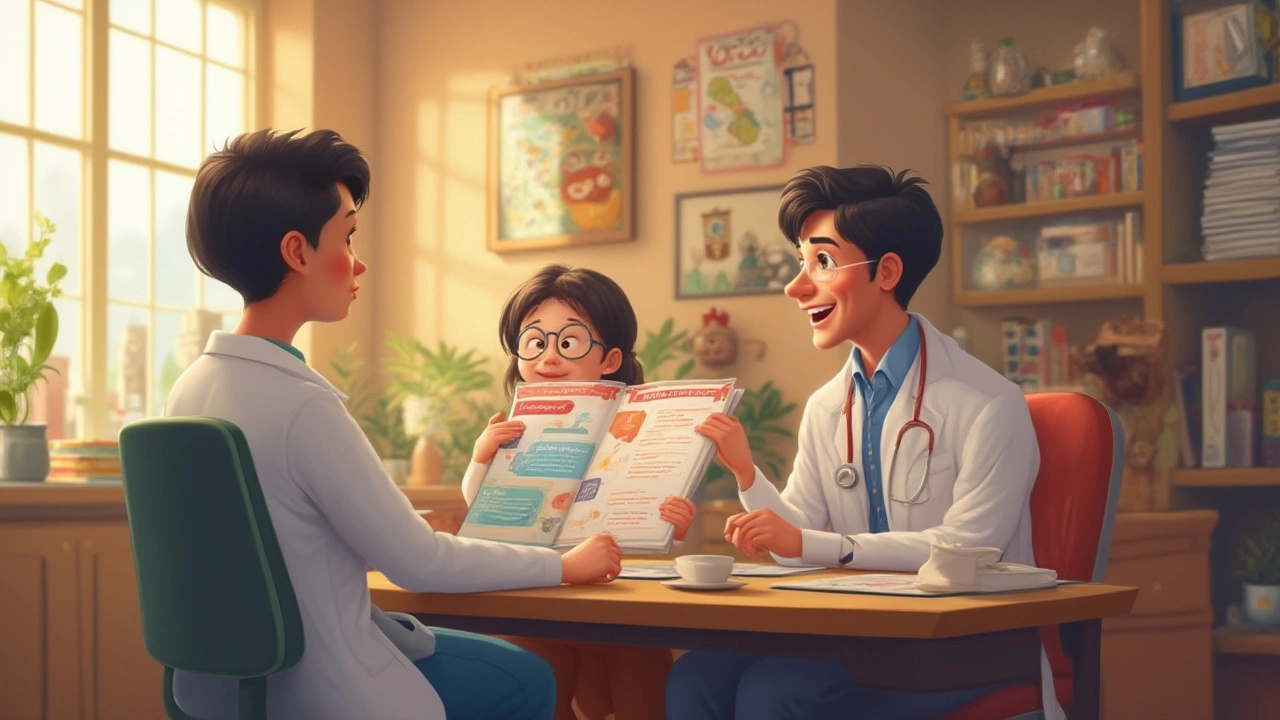If you’ve scrolled through NHS headlines lately, you’ll notice a string of stories about antibiotics losing their punch. Bacteria are fighting back, outsmarting our best drugs at every turn. Penicillin—the old superhero—has been sidelined by resistance in loads of infections. That leaves everyone asking: Is ampicillin, a close cousin, still on our side or has it joined the list of remedies that just don’t cut it anymore?
Why Penicillin Resistance Is Exploding
Back in the day, penicillin saved countless lives with almost magical results. Seriously, hospitals in 1943 transformed overnight. Infections that killed suddenly bent the knee. But time hasn’t been kind. Infections like Strep throat and pneumonia once melted away with penicillin but now increasingly refuse to budge. What changed? Bacteria did. They adapted, growing enzymes like beta-lactamase, which chews through the penicillin molecule as if it were a biscuit at tea time.
Factors behind this? You’ve probably guessed—overuse. In the UK, about 39 million antibiotic prescriptions are given out yearly just by GPs. Not all those cases truly need them. Colds, viral coughs, and ear aches—most will clear on their own, but old habits die hard. Over time, this means more bugs survive, learn, and share their resistance with neighbours. Hospitals face this daily. Only about 10% of Staphylococcus aureus, for example, are still sensitive to penicillin in NHS hospitals. The rest shrug it off, thanks to decades of misuse and missed doses.
There’s another sneaky route: animal farming. Antibiotics slip into food production to keep livestock infection-free, even when they aren’t sick. This creates “superbugs” in the food chain. Imagine biting into a chicken sandwich that trained bacteria to resist drugs your doctor may need one day. Not something you want as a side dish.
Certain infections are now almost untouchable with regular penicillins. In urinary tract infections (UTIs), for example, E. coli used to quickly fade with a prescription. Now, at least a third strain in hospital settings show penicillin resistance. This rampant spread has changed the playbook for every GP.
The symptoms of this arms race aren’t always dramatic—sometimes, people just don’t get better. Or they bounce back sick after a short course, or their “mild” infection suddenly becomes a hospital emergency. It’s not just about penicillin. Resistance to amoxicillin and even stronger antibiotics is snaking upwards across wards and clinics—this summer alone, UK labs recorded ampicillin resistance in about 58% of blood E. coli samples, compared to almost zero decades ago.

Is Ampicillin Still Effective in 2025?
People often assume that ampicillin must be safe from resistance because it’s a little different from regular penicillin. If only. Ampicillin is certainly broader—it targets both some Gram-positive and Gram-negative bacteria (think E. coli, Salmonella, Enterococcus faecalis). But resistance is catching up fast. So doctors here in Birmingham, from rapid-access clinics to city hospitals, now pay sharp attention to lab results before prescribing.
Recent figures from Public Health England (PHE) show a steady decline in ampicillin’s effectiveness. With E. coli, resistance rates in blood cultures now exceed 55% nationwide. The impact isn’t only in big hospitals—a local Birmingham clinic ran a five-year audit and found just under half of urinary E. coli infections still responded to ampicillin. The rest needed extra rounds of treatment, often with more expensive or side-effect-prone antibiotics.
What about chest infections? If you’ve got community-acquired pneumonia (CAP) in 2025, unless a test suggests otherwise, GPs rarely reach for ampicillin first. Why? Because Streptococcus pneumoniae—once sensitive—is more likely to come back resistant. National data suggest 20-30% of UK CAP samples in adults now resist ampicillin. You can see how quickly things have shifted from our parents’ generation, where nearly everyone got better on a simple prescription.
Some bugs, however, haven’t caught up. For instance, certain strains of Enterococcus faecalis (think stubborn urinary infections in elderly care homes) are still about 85% sensitive, according to NHS Trust labs across the Midlands. It means that ampicillin still plays a role in selected, test-guided cases instead of being the default choice for everyone.
This is why treatment must be personal now. Doctors are urged to check “susceptibility reports”—lab letters showing what antibiotics actually work in each case. No point guessing anymore. This data-driven style is changing everyday prescribing here and across the UK. A GP might send a sample and tell you, “Let’s hold off until the results come back.” That delay, though tough when you’re miserable, is often your best chance of actually getting better with the right drug first try.
For those curious about the nitty-gritty—dosages and full clinical scenarios—there’s a terrific, easy-reading breakdown worth a look on Ampicillin efficacy. It’s got clear sections on how doctors choose, warnings, and some practical tips you won’t find in most leaflets or patient handouts.
| Bacteria | UK Resistance to Ampicillin | 2021 | 2025 |
|---|---|---|---|
| E. coli (UTI) | High | 50% | 58% |
| Strep pneumoniae | Moderate | 18% | 26% |
| Enterococcus faecalis | Low | 12% | 15% |
| Salmonella spp. | Moderate | 27% | 32% |
So whether you’re a worried parent, a carer, or someone with a track record of UTIs, the numbers are worth knowing. “Broad-spectrum” isn’t the same as “fool-proof” anymore.

Smart Prescribing: Navigating the Resistance Maze
What do you do when the old standbys are wobbling? For doctors, it means thinking like a detective. Instead of reaching for the *same-old* for a sniffle or mild infection, proper checks and balances are the new normal.
Every GP in Birmingham gets NHS training on antimicrobial stewardship—a fancy way of saying “don’t give out these tablets unless you’re sure.” For something like suspected UTI, a sample goes to the lab, and only if results say “Yes, it works!” does ampicillin come off the shelf. If not, it’s on to something stronger—maybe nitrofurantoin, maybe a different family entirely. This helps slow down resistance, because we’re using the right bullet for the right job, not carpet-bombing everything in sight.
If you’re on the other side—receiving a prescription—there are simple things you can do to help too. Always finish the entire course, even if you feel better. Skipping doses lets the toughest bacteria hide out and multiply. And don’t pressure for antibiotics “just in case.” If your doctor suggests waiting or gives self-care advice for a mild cough or cold, it’s not because they’re stingy—it’s because you’ll heal, and you’re helping preserve antibiotic power for when you really need it.
- Only use antibiotics when a healthcare professional says it’s necessary (not for viruses like colds).
- Ask your GP or pharmacist what infections ampicillin still works for, based on local data.
- Take every dose at the exact time—don’t skip or double up.
- Never share leftover antibiotics—even if a mate or family member thinks their symptoms are the same.
- If you work in childcare or have young kids, be open to advice about “supportive care”—calpol, fluids, rest—because most illnesses do better this way unless complications hit.
- Be open to delayed prescriptions (take your script to the pharmacy only if symptoms worsen or don’t start clearing as expected).
Doctors now track resistance patterns nearly in real time through NHS digital dashboards and local Trust bulletins. So if, for example, next year a certain bug is caught in a Birmingham school with 90% ampicillin resistance, you can guarantee local doctors will switch to an alternative without delay. This keeps patients safer and slows resistance more than blanket policies ever could.
And here’s a small but important tip—if you’ve got a hospital appointment, don’t be shy about mentioning your recent antibiotic history, even for dental or skin infections. It may alter your treatment or the tests the consultant orders.
One last fact: as many as 10,000 deaths across Europe each year are now linked to antibiotic-resistant infections. But in places where both patients and prescribers stick with smarter habits, rates of “untreatable” infections are lower. Think of it as a team effort—protecting the power of antibiotics for our families, now and far down the road.


Comments (6)
Hadrian D'Souza
July 23, 2025 AT 06:32Oh wow, another ‘antibiotics are dying’ thinkpiece. Congrats, you’ve noticed that bacteria don’t read NHS brochures. Beta-lactamase? More like beta-lactam-‘I-saw-your-prescription-and-laughed’. Ampicillin’s not dead-it’s just been replaced by the cool kids on the block, like ceftriaxone and meropenem. The real tragedy? We kept using penicillin like it was a lucky charm instead of a relic from the stone age. At this point, prescribing ampicillin without a culture is like using a flip phone in 2025-adorable, but you’re gonna get ghosted by the network.
And don’t even get me started on ‘antibiotics for colds’. That’s like trying to fix a broken Wi-Fi with a hammer. The only thing growing faster than resistance is the number of people who think ‘antibiotic’ is just a synonym for ‘feeling better’.
Also, chicken sandwiches? Please. The real superbug is the person who thinks ‘natural’ means ‘immune to consequences’. You want to blame farming? Fine. But let’s not pretend your grandma’s 1972 amoxicillin prescription was some kind of sacred pact with the microbiome gods.
TL;DR: Ampicillin’s not dead. It’s just been demoted to backup singer in a band where the lead vocalist is now called ‘Carbapenem’.
Also, your link? Adwayet.com? That’s not a journal. That’s a WordPress blog run by a guy who thinks ‘pharmacokinetics’ is a type of yoga. But hey, at least it’s got bold fonts.
Brandon Benzi
July 25, 2025 AT 04:37This is why America needs to stop letting Europe tell us how to do medicine. We don’t need your lab reports and your ‘susceptibility data’. Back in my day, you took the pill your doctor gave you and didn’t ask questions. Now we’ve got people checking their E. coli like it’s a Tinder profile. Ampicillin’s still good enough for most folks. You think we’re gonna let some bacteria in a petri dish dictate how we treat our families? No. We fight back. With antibiotics. And pride.
And don’t even get me started on ‘delayed prescriptions’. That’s just the NHS way of saying ‘wait until you’re dying’. We don’t do that in America. We fix it. Fast. No waiting. No tests. Just give me the strong stuff and shut up.
Also, your ‘team effort’ nonsense? We don’t need your ‘smart prescribing’. We need strong men and women who take their medicine like soldiers. Not little lab rats with spreadsheets.
Abhay Chitnis
July 27, 2025 AT 01:35Bro, this is why India is winning the antibiotic game 😎
We’ve been using ampicillin since the 80s and still got 70% efficacy in rural clinics because we don’t waste it on viral coughs. Here in Mumbai, we use it for UTIs, ear infections, and even that weird skin rash your cousin got after the wedding. No culture? No problem. We know the bugs here. They don’t fool us.
Meanwhile, UK doctors are sending samples to labs like they’re ordering Uber Eats. 😂
Also, your ‘superbugs from chicken sandwiches’? Bro, we eat street chicken every day and still walk. You think we’re scared of E. coli? We’ve got resistance built into our DNA. 🤙
PS: Your table says 58% resistance? That’s still better than the 90% we saw in Delhi last year. We’re ahead of the curve. You’re just catching up with a spreadsheet.
PPS: Adwayet.com? That’s not even a real site. I checked. 😏
Robert Spiece
July 27, 2025 AT 15:54Resistance isn’t a bug. It’s a feature of evolution. We didn’t lose ampicillin. We outgrew it. Like shoes that no longer fit. The bacteria didn’t betray us-they simply reflected our arrogance. We treated antibiotics like candy, not catalysts. We gave them time to learn, to adapt, to become smarter than our prescriptions.
And now we’re surprised? We’re the ones who taught them to speak our language. We wrote the syllabus: ‘Take one pill, skip two, save the rest for next time.’ We were the professors. They were the students. And now, they’ve graduated.
The real tragedy isn’t that ampicillin fails. It’s that we still think medicine is about control. But nature doesn’t negotiate. It doesn’t care about your NHS guidelines or your ‘smart prescribing’. It just is.
Maybe the question isn’t ‘Is ampicillin still effective?’
It’s ‘Are we still worthy of being treated?’
And if we keep treating bacteria like enemies to be bombed, we’ll keep losing. Not because they’re strong.
But because we’re foolish.
Vivian Quinones
July 29, 2025 AT 11:16I don’t care what the data says. My cousin took ampicillin for her UTI last year and felt better in two days. So it works. End of story. Why are we making this so complicated? It’s just a pill. You don’t need a PhD to take it. Doctors are just scared to say the truth: we need to give people what works, not what some lab says on a chart.
Also, why are we blaming farmers? We’re the ones eating the chicken. If the chicken’s got bugs, it’s our fault for buying cheap meat. Fix the system, not the prescription.
And why are we letting bacteria win? We’re humans. We invented medicine. We can beat this. Just give us the strong stuff and stop talking about ‘resistance patterns’ like it’s a weather report.
Also, your link? I clicked it. It looked like a scam. I’m not clicking it again.
Eric Pelletier
July 29, 2025 AT 13:23Let’s clarify some clinical nuances here. Ampicillin’s utility isn’t dead-it’s contextual. Its spectrum remains valuable against susceptible Enterococcus faecalis (still ~85% sensitive in many UK trusts), Listeria monocytogenes, and some non-ESBL-producing E. coli in low-resistance communities. The 58% resistance rate in blood cultures? That’s driven by ESBL-producing Enterobacteriaceae, which are typically community-acquired now, not just hospital-borne.
What’s critical is distinguishing between empirical and targeted therapy. Ampicillin + clavulanate (amoxicillin-clav) still has broader coverage due to the beta-lactamase inhibitor, but ampicillin monotherapy? Only when susceptibility is confirmed. That’s why culture-guided prescribing is non-negotiable now.
For CAP, the IDSA/ATS guidelines now recommend macrolides or doxycycline as first-line for outpatients, not ampicillin, precisely because pneumococcal resistance has crept above 20%. Inpatient regimens? Ceftriaxone + azithromycin, period.
And yes-antibiotic stewardship isn’t bureaucracy. It’s pharmacokinetic hygiene. Every unnecessary dose is a selective pressure event. We’re not just treating patients-we’re managing microbial ecosystems. Think of it like a garden: you don’t spray glyphosate on every weed. You identify the species, then pick the herbicide.
For patients: If your GP says ‘wait and see’ for a mild URI? Trust them. 90% of those resolve without antibiotics. The real risk isn’t waiting-it’s contributing to resistance that will kill your grandkids when they need a hip replacement or chemo.
Final note: The data in that table? Solid. PHE’s 2025 surveillance report confirms it. But the takeaway isn’t ‘ampicillin is obsolete.’ It’s ‘precision matters.’